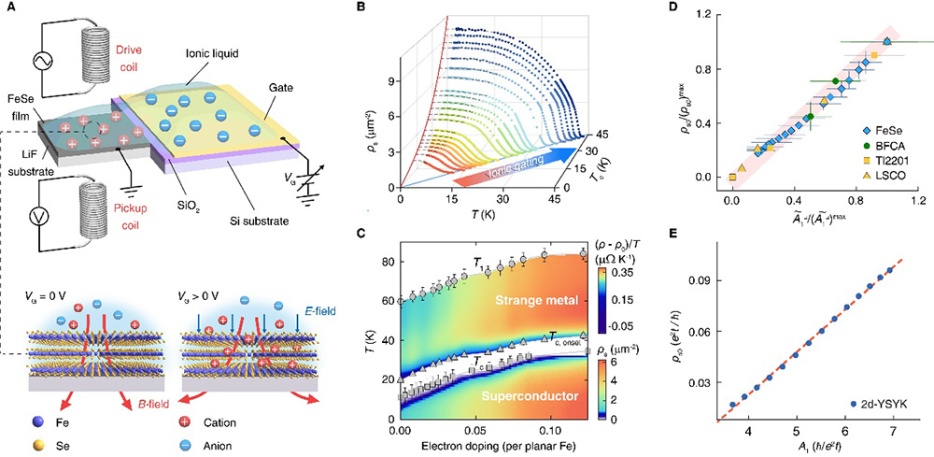

The mystery of high-temperature superconductivity has puzzled physicists for decades. In high-temperature superconductors, electrons form Cooper pairs and flow without resistance below a critical temperatureTc, while their behavior aboveTc is even more enigmatic. Particularly, many unconventional superconductors exhibit “strange metal” behavior in the normal state, with electrical resistance increasing linearly with temperature, contrary to conventional theories. Understanding the connection between this strange metallicity and unconventional superconductivity is key to unlocking the mechanism of high-temperature superconductivity.
The group led by Jin Kui at the Institute of Physics (IOP) of the Chinese Academy of Sciences (CAS), had already laid a crucial foundation in previous work. Using high-throughput experimental techniques, the team discovered a universal scaling law betweenTc and the strange-metal resistivity coefficient A1 in both cuprate and iron-based superconductors, showing thatTc∝ (A1)0.5. These pioneering findings provided direct evidence that the scattering mechanism in strange metals is fundamentally connected to electron pairing in high-temperature superconductors.
Based on these discoveries, Jin’s team has achieved another breakthrough. In their latest study published in Science Advances, they further revealed a linear relationship between superfluid density (a key parameter characterizing the superconducting state) and the strange-metal resistivity coefficient. This finding directly couples Cooper pair condensation to normal-state electron scattering, revealing a deeper connection between these two phenomena. It unambiguously demonstrates that the same interaction that underlies the strange-metal behavior gives rise to the electron pairing and condensation in high-temperature superconductors.
The research team overcame substantial technical challenges by developing a novel experimental approach that integrates ionic liquid gating with operando two-coil mutual inductance measurements. This innovative setup allowed them to precisely tune the superconducting properties of FeSe films while simultaneously measuring changes in superfluid density with high accuracy. With this capability, they systematically variedTc from 11 K to 43 K in a single FeSe sample, observing a clear power-law relationship betweenTc and zero-temperature superfluid density ρs0:Tc ∝(ρs0)0.55±0.11.
Most remarkably, a linear scaling between ρs0 and A1 emerged, derived from normal-state electrical transport data. This relationship holds true for both iron-based and cuprate superconductors, despite their different electronic structures and pairing symmetries. Theoretical collaboration with SACHDEV Subir’s group at Harvard University showed that this universal behavior could be quantitatively reproduced by the two-dimensional Yukawa-Sachdev-Ye-Kitaev model, which accounts for the cooperative effects of quantum critical fluctuations and disorder. These quantitative relationships suggest a common mechanism may govern both strange metallicity and unconventional superconductivity, representing a significant advance in understanding the mysterious mechanism behind high-temperature superconductivity.
This study, entitled “Correlation between unconventional superconductivity and strange metallicity revealed by operando superfluid density measurements” was published in Science Advances.

Revealing quantitative connection between superfluid density and the strange-metal resistivity in FeSe. A. Schematic of the ionic-liquid gating and the operando superfluid density measurements. B. Temperature-dependent superfluid density for the ion-gated FeSe films. C. Synchronized evolution of the strange-metal phase and the superfluid condensate. D. Scaling across different superconducting systems. E. Theoretical calculations based on the 2D-YSYK model. [IMAGE: IOP]
For more information, please contact:
Jin Kui
E-mail: kuijin@iphy.ac.cn
Institute of Physics,
Chinese Academy of Sciences
Source: Institute of Physics,
Chinese Academy of Sciences